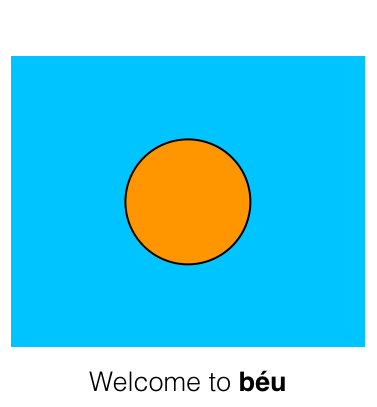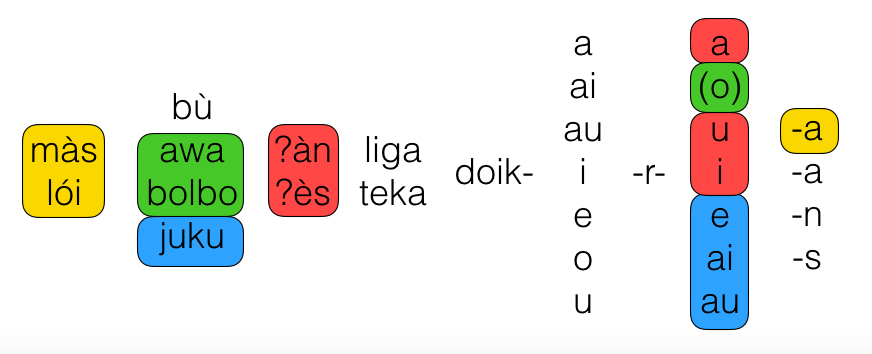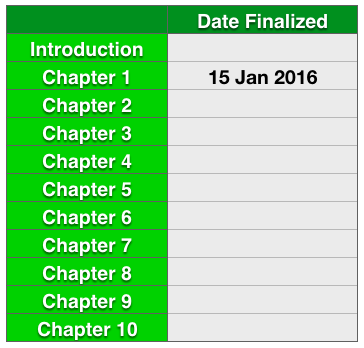Introduction to Béu
..
The development of "Harweng" and "Seuna" ground to a halt because I lacked linguistic knowledge at that time. béu is the third language that I have started to construct. I intend that it will be a fully formed language and have hopes to finish it in a few more years.
What interests me most in linguistics is the area where logic, grammar and semantics intersect.
I devised the script before deciding on a name to give the language. The name béu I considered the most visually appealing word in the scripts and hence the conlang's name (actually I have named the whole constructed culture béu). The red symbol on black background which you can see at the top of this page (on the left and on the right) is the word béu. Pretty cool, eh ? I think it can hold its own when up against "AUM" or "FU".
..
..
..... The tones system
..
The first noteworthy thing about ‘’’béu’’’ is the 3 tones … all monosyllables having either a high tone or a low tone. There were three motivations for that …
* Inevitably multisyllable words are built up from monosyllables. The total number of possible monosyllables allowed by the phonology of ‘’’béu’’’ are nearly all assigned a meaning. I did not want any hint of these meanings surfacing in multisyllable words so it seemed that a good way to distance a word from the monosyllabic words which could comprise it, was to have all multisyllable words in neutral tone and all monosyllabic words in high or low tone.
* A good percentage of the words languages have tones. I wanted ‘’’béu’’’ to be typical of all the world languages.
* It doubles the number of possible monosyllabic words.
Well these were the motivations. I later made the set of “question words” correspond to the equivalent “generic noun” by means of a tone change. Also I later made the ergative pronouns differ in tone from the absolutive ones in order to distinguish them more.
..
My primary motivation in construction ‘’’béu’’’ was to make a language that would aesthetically please me. Now the natural languages which I like tend to be simple … simple phonology, simple phonotactics and simple grammar. For example Swahili, Thai, Indonesian or Chinese. Now these four languages are not a million miles away from each other in terms of structure. They all have nouns, verbs and adjectives. They all sample reality with the same pixel size (actually I believe all natural languages are similar with respect to this parameter … the only outliers that I know to exist are the conlangs “Ithkuil” and “Toki Pona”, and maybe the natlang “Tok Pisin”). And they are all pretty isolating (the Swahili verb can incorporate a few elements … but there are no irregularities). It has been suggested that the reason that these languages (at least some of them) are so simple is that they were at one time a creole. What developes into a creole is what is called a "contact language" … just a list of words taken from two or three languages. However very soon certain words are grammaticized to give some tense aspect information to the verb. Then other rules solidify and other bit of grammaticization occur. The result is a creole. All creoles are very simple languages.
I was aiming for the simplicity of a creole. However I believed that I could make a more “efficient” tense/aspect/evidential system than a creole. Instead of diverse elements incorporated into the Verb Phrase chaotically, I … as creator could design a compact, comprehensive paradigm from the get-go.
..
..... The tense/aspect/evidential paradigm
..
The second noteworthy thing about béu is its tense/aspect/evidential paradigm. This is shown below …
For more information on the above go to section 2 in chapter 3.
..
Apart from the above mentioned tones and tense/aspect/evidentials, there is not much worth mentioning about the language of béu … the case system is really not much more than a short-hand convention.
..
..... Beyond the language
..
The third noteworthy thing about béu is how it has expanded from a language to embrace all aspects of life.
I have a feeling that after the language of ‘’’béu’’’ is done and dusted, ‘’’béu’’’ will continue to expand in non-linguistic directions.
For example …..
béu specifies "best practices" for many many aspects of life. There are 3 levels for "things you must do" and 2 levels of prohibition.
The relationship of husband and wife, parent and child, employer and employee, etc. etc are defined in quite some detail.
Technical standards such as screw shapes and sizes, etc. etc are defined in detail.
The time of year and the manner of the five big festivals are defined.
Even some metaphysics are defined. For example ...
aŋgwa is an important concept. The closest translation to it is "harmony".
When used in relation to motion it can be translated as "grace" When used in relation to design it can be translated as "elegance" When used in relation to text it can be translated as "poetry"
The adjective corresponding to aŋgwa is aŋgwai
aŋgwa is considered getting the right balance between honda "order" and aska "chaos".
honda and aska are considered two complementary rather than opposing concepts/forces ... a bit like YIN + YANG.
honda and aska are each associated with 4 further concepts (and ONLY these 4 concepts).
Two of these concepts being nouns (dark blue) and two adjectives (red).
The origin of angwa are lost in the mists of time. Probably the ancestral béu community just felt that it felt right. And in these empirical times, the idea of angwa is still of central importance to béu. For example if somebody shows you around a park, they will point out what features are honda and which are aska. Nowadays the concepts of angwa live alongside but separate from modern scientific ideas. By the way the béu flag can be seen at the top of the page (centre). The flag is reflects the aska/honda dualism that permeates the béu way of life.
..
..... Addendum
..
When talking about grammar I follow the lead given by R.M.W. Dixon in "Basic Linguistic Theory". I would thoroughly recommend this book. As well as giving a broad topological perspective of the World's languages, it puts the convoluted terminology that has grown up in the field of linguistics over the years, firmly in its place.
..
..... Progress
..
..
Index
- Introduction to Béu
- Béu : Chapter 1 : The Sounds
- Béu : Chapter 2 : The Noun
- Béu : Chapter 3 : The Verb
- Béu : Chapter 4 : Adjective
- Béu : Chapter 5 : Questions
- Béu : Chapter 6 : Derivations
- Béu : Chapter 7 : Way of Life 1
- Béu : Chapter 8 : Way of life 2
- Béu : Chapter 9 : Word Building
- Béu : Chapter 10 : Gerund Phrase
- Béu : Discarded Stuff
- A statistical explanation for the counter-factual/past-tense conflation in conditional sentences






